It’s been a year, which means it’s time to start asking yourself a few questions. In the last 12 months, have you worn those bright red skinny jeans? How many times have you used two blenders at the same time? Did you change your furnace filter? When you think spring cleaning, you typically imagine going through closets-full of clothes and any overflowing cabinets. But if you aren’t thinking about cleaning up your home’s energy usage, you’re falling short.
As you overhaul your home this spring, think about these four energy-saving tips.
Tip 1: Dust it Off
 Dust balls don’t just make you sneeze. Even a thin layer of filth can inhibit the performance of your computer, ceiling fans, light bulbs and air vents. When your light bulbs are crystal-clear, they provide more light so you may not need to turn on as many. Energystar.gov estimates that just one extra bulb left on for eight hours a day can cost you $20 per year. Meanwhile, PC World says the buildup of dirt, hair and other debris can affect your computer’s cooling fans, or even push components out of place. This could not only cause your computer to run slowly, but possibly not at all. Take a minute to clean up your electronics before assuming they’re better left for the trash.
Dust balls don’t just make you sneeze. Even a thin layer of filth can inhibit the performance of your computer, ceiling fans, light bulbs and air vents. When your light bulbs are crystal-clear, they provide more light so you may not need to turn on as many. Energystar.gov estimates that just one extra bulb left on for eight hours a day can cost you $20 per year. Meanwhile, PC World says the buildup of dirt, hair and other debris can affect your computer’s cooling fans, or even push components out of place. This could not only cause your computer to run slowly, but possibly not at all. Take a minute to clean up your electronics before assuming they’re better left for the trash.
Tip 2: Filter Through Filters and Bulbs
 While you’re dusting off light fixtures, replace any incandescent bulbs with compact florescent light (CFL) bulbs that last much longer and pay for themselves in just over a year. Though you won’t be replacing CFL bulbs as often, you’ll still need to change furnace and air conditioning filters regularly. Otherwise, a dirty HVAC filter weighs down your system and makes it work harder than usual.
While you’re dusting off light fixtures, replace any incandescent bulbs with compact florescent light (CFL) bulbs that last much longer and pay for themselves in just over a year. Though you won’t be replacing CFL bulbs as often, you’ll still need to change furnace and air conditioning filters regularly. Otherwise, a dirty HVAC filter weighs down your system and makes it work harder than usual.
Tip 3: Plant a (Money-Saving) Tree
 Plan to spruce up the outside of your house, too? Well, you should. Sunnier days and spring showers offer an opportune time to plant trees and flowers that will ultimately cut down on your home’s energy consumption. On the south and west sides of your house, plant a few trees that will lose their leaves in the fall. This smart and simple landscaping will shade your home in the summer and allow the sun to shine through the windows in the winter – it’s like free solar heating.
Plan to spruce up the outside of your house, too? Well, you should. Sunnier days and spring showers offer an opportune time to plant trees and flowers that will ultimately cut down on your home’s energy consumption. On the south and west sides of your house, plant a few trees that will lose their leaves in the fall. This smart and simple landscaping will shade your home in the summer and allow the sun to shine through the windows in the winter – it’s like free solar heating.
Tip 4: Seal the Deal
 While washing windows and sliding glass doors, check to see if any of them could use weatherstripping or even just a good cleaning. You may have already sealed their edges, but this is a good time for a status update. The weatherstripping may need to be replaced completely, or the tracks may need to be wiped down. Clean tracks will help keep the seal tight, so air doesn’t escape or come in. According to Energystar.gov, you could save up to $200 annually by sealing air leaks and keeping your home well-insulated.
While washing windows and sliding glass doors, check to see if any of them could use weatherstripping or even just a good cleaning. You may have already sealed their edges, but this is a good time for a status update. The weatherstripping may need to be replaced completely, or the tracks may need to be wiped down. Clean tracks will help keep the seal tight, so air doesn’t escape or come in. According to Energystar.gov, you could save up to $200 annually by sealing air leaks and keeping your home well-insulated.
With a completely cleaned-up home, you’ll feel productive, your home will run more efficiently and your bank account will relax – at least until summer vacations start.


 Just like at home, your office can fall victim to
Just like at home, your office can fall victim to  Computers, monitors, copiers, and modems are the major office appliances that use the most electric in the office. A study done by
Computers, monitors, copiers, and modems are the major office appliances that use the most electric in the office. A study done by  Pedal-A-Watt is a bike stand that turns human power into energy watts. A well-conditioned cyclist could generate up to 400 watts, which is enough to power small household appliances.
Pedal-A-Watt is a bike stand that turns human power into energy watts. A well-conditioned cyclist could generate up to 400 watts, which is enough to power small household appliances.  This refers to a vegetative layer grown on top of your home, also known as “green roofs.” Depending on the structure and surface area you’re working with, this could mean a two-inch covering or a flourishing park with trees. According to the
This refers to a vegetative layer grown on top of your home, also known as “green roofs.” Depending on the structure and surface area you’re working with, this could mean a two-inch covering or a flourishing park with trees. According to the 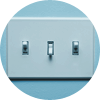 You’ve i
You’ve i A
A  Draining and cleaning your water heater every six months will make the system run more efficiently. It also avoids the chance of the bottom of your water heater rusting from sedimentation buildup. Debris can clog pipes and pollute your clean water, disrupting the water flow and costing you more money.
Draining and cleaning your water heater every six months will make the system run more efficiently. It also avoids the chance of the bottom of your water heater rusting from sedimentation buildup. Debris can clog pipes and pollute your clean water, disrupting the water flow and costing you more money.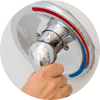 Between showering, washing your hands, and running the dishwasher or washing machine, you use a large portion of hot water, driving up your water heating bills every year. According to Home Water Works, dishwashers use up to
Between showering, washing your hands, and running the dishwasher or washing machine, you use a large portion of hot water, driving up your water heating bills every year. According to Home Water Works, dishwashers use up to  Lowering the temperature of your water heater to 120⁰ Fahrenheit can reduce costs dramatically. You can cut energy costs by as much as
Lowering the temperature of your water heater to 120⁰ Fahrenheit can reduce costs dramatically. You can cut energy costs by as much as 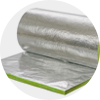 If you have an older water heater, chances are it is not insulated. Having an insulated water heater will reduce its standby heat loss by as much as 45% and can save you anywhere from
If you have an older water heater, chances are it is not insulated. Having an insulated water heater will reduce its standby heat loss by as much as 45% and can save you anywhere from  Approximately
Approximately 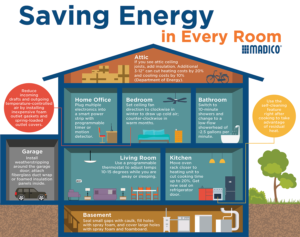
 Time for laundry. Unless you have heavily soiled items, wash with cold water. According to the
Time for laundry. Unless you have heavily soiled items, wash with cold water. According to the  Begin the energy savings process before heading off to work by preparing your home for the decrease in family activity time. Unplug electronics and chargers; turn off lights and fans; close curtains from summer heat, or angle blinds upward in winter to capture daytime sun warmth. Raise or lower your thermostat to keep it from running too frequently in an empty house.
Begin the energy savings process before heading off to work by preparing your home for the decrease in family activity time. Unplug electronics and chargers; turn off lights and fans; close curtains from summer heat, or angle blinds upward in winter to capture daytime sun warmth. Raise or lower your thermostat to keep it from running too frequently in an empty house. Frustrated with the electric bill that came in the mail today? Walk over to the water heater and check the temperature setting. Most water heaters are set at 140 degrees, but could be just as effective at 120 degrees, which according to the EPA, provides the potential to cut costs by 6-10%. For electric water heaters, save money by installing an inexpensive timer that turns it off at night when you aren’t using hot water.
Frustrated with the electric bill that came in the mail today? Walk over to the water heater and check the temperature setting. Most water heaters are set at 140 degrees, but could be just as effective at 120 degrees, which according to the EPA, provides the potential to cut costs by 6-10%. For electric water heaters, save money by installing an inexpensive timer that turns it off at night when you aren’t using hot water. You’re going to need extra coffee this morning to get through “hump day.” Instead of leaving your coffee maker’s warmer on while getting ready, shut it off as soon as the brewing is complete and pour the rest into a thermos to keep it warm. Why? Even immediately powering down this simple appliance offers nearly
You’re going to need extra coffee this morning to get through “hump day.” Instead of leaving your coffee maker’s warmer on while getting ready, shut it off as soon as the brewing is complete and pour the rest into a thermos to keep it warm. Why? Even immediately powering down this simple appliance offers nearly  Running errands? Pop in the hardware store, and get caulk or weatherstripping to seal air leaks. Dirty spots on your ceiling paint and carpet may indicate air leaks that need caulking at joints and joists. Hold an incense stick near plumbing fixtures, electrical boxes, and ceiling fixtures. If the smoke moves horizontally, seal up these air leaks as well.
Running errands? Pop in the hardware store, and get caulk or weatherstripping to seal air leaks. Dirty spots on your ceiling paint and carpet may indicate air leaks that need caulking at joints and joists. Hold an incense stick near plumbing fixtures, electrical boxes, and ceiling fixtures. If the smoke moves horizontally, seal up these air leaks as well. Backyard get-together tonight! Conserve water by cleaning driveways and sidewalks with a broom instead of a hose. Accent your space with solar lights and candles in place of bulb energy. Leave the stove off, and put your grill-master to work. Unplug your portable music player, and use rechargeable batteries to power up background music. Get the kids away from energy-draining video games, and plan some electricity-free competitions!
Backyard get-together tonight! Conserve water by cleaning driveways and sidewalks with a broom instead of a hose. Accent your space with solar lights and candles in place of bulb energy. Leave the stove off, and put your grill-master to work. Unplug your portable music player, and use rechargeable batteries to power up background music. Get the kids away from energy-draining video games, and plan some electricity-free competitions! When you get the duster out to clean, don’t forget to use it on light fixtures and bulbs. Dust can absorb 50% of light, making you want to turn on more lighting than necessary. Dusty air conditioner or furnace filters, refrigerator coils and vents all add to more energy usage as well. Even dust on electronics can force their fans and motors to run harder, eating up more electricity.
When you get the duster out to clean, don’t forget to use it on light fixtures and bulbs. Dust can absorb 50% of light, making you want to turn on more lighting than necessary. Dusty air conditioner or furnace filters, refrigerator coils and vents all add to more energy usage as well. Even dust on electronics can force their fans and motors to run harder, eating up more electricity. What’s the big deal with LED (light-emitting diode) holiday lights? You can reap up to 70-90% energy savings! Your old incandescent or florescent lights consume between 40-175 watts of power per string, while an LED string consumes just 2-4 watts. According to the
What’s the big deal with LED (light-emitting diode) holiday lights? You can reap up to 70-90% energy savings! Your old incandescent or florescent lights consume between 40-175 watts of power per string, while an LED string consumes just 2-4 watts. According to the  Typically, rope lights use miniature incandescent bulbs spaced apart in flexible plastic tubing. There are LED rope lights on the market, but if you can’t find them in your store, you can still save energy with standard ropes. The tiny incandescents consume only 0.5 watts of electricity per foot and can last more than 20,000 hours.
Typically, rope lights use miniature incandescent bulbs spaced apart in flexible plastic tubing. There are LED rope lights on the market, but if you can’t find them in your store, you can still save energy with standard ropes. The tiny incandescents consume only 0.5 watts of electricity per foot and can last more than 20,000 hours. Thinking about getting a new Christmas tree? Save energy with a fiber optic tree. These trees use a single bulb to transmit electricity along tiny fibers throughout the branches. The fibers light up the entire tree, often in alternating colors, and stay cool to the touch. With only one 5-20 watt bulb consuming energy on your tree, you are saving money and eliminating the task of hanging and removing lights.
Thinking about getting a new Christmas tree? Save energy with a fiber optic tree. These trees use a single bulb to transmit electricity along tiny fibers throughout the branches. The fibers light up the entire tree, often in alternating colors, and stay cool to the touch. With only one 5-20 watt bulb consuming energy on your tree, you are saving money and eliminating the task of hanging and removing lights.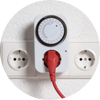 Whatever lights you use, leaving them on all day or after you’ve gone to bed runs up your electric bill unnecessarily. Invest in timers to turn on and off your outdoor and indoor lights for you. Inflatable decorations are some of the most energy-sucking items you can display (150-200 watts per hour), and timers eliminate the need to remember to shut off their fans and lights after viewing time has passed.
Whatever lights you use, leaving them on all day or after you’ve gone to bed runs up your electric bill unnecessarily. Invest in timers to turn on and off your outdoor and indoor lights for you. Inflatable decorations are some of the most energy-sucking items you can display (150-200 watts per hour), and timers eliminate the need to remember to shut off their fans and lights after viewing time has passed. Candles are a great electric-free option that can be used in outdoor luminaries. Even with shorter daylight hours, solar-powered luminaries, strings, and ornaments can soak up enough sunlight to illuminate your yard or tree for plenty of enjoyment. If you just can’t give up tree lights, cut down the amount by decorating with shiny ornaments, garland or tinsel that reflect light and add brilliance. Turn off overhead lighting when your tree is on, and the soft glow will still provide enough light to navigate the room.
Candles are a great electric-free option that can be used in outdoor luminaries. Even with shorter daylight hours, solar-powered luminaries, strings, and ornaments can soak up enough sunlight to illuminate your yard or tree for plenty of enjoyment. If you just can’t give up tree lights, cut down the amount by decorating with shiny ornaments, garland or tinsel that reflect light and add brilliance. Turn off overhead lighting when your tree is on, and the soft glow will still provide enough light to navigate the room.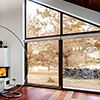 Use the sun’s heat to warm your home on sunny days by opening the window coverings of your south- and west-facing windows. You can
Use the sun’s heat to warm your home on sunny days by opening the window coverings of your south- and west-facing windows. You can 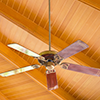 Most of us will turn back the clock for the winter months, which is also a reminder to change your smoke alarm batteries. While you have the step stool out, change the direction of your ceiling fans, too. In colder months, ceiling fans should rotate clockwise. You know that hot air rises. By reversing the fan’s direction, you draw colder floor air to the ceiling, mixing it with warmer air and sending it back down your walls. This trick allows you to turn down the thermostat a bit to give your heating unit a break, but keep fans on the lowest setting or too much moving air can chill you instead.
Most of us will turn back the clock for the winter months, which is also a reminder to change your smoke alarm batteries. While you have the step stool out, change the direction of your ceiling fans, too. In colder months, ceiling fans should rotate clockwise. You know that hot air rises. By reversing the fan’s direction, you draw colder floor air to the ceiling, mixing it with warmer air and sending it back down your walls. This trick allows you to turn down the thermostat a bit to give your heating unit a break, but keep fans on the lowest setting or too much moving air can chill you instead.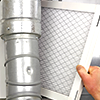 Waiting to
Waiting to 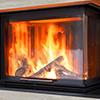 If you have a fireplace that isn’t used, seal it off to keep heat from escaping. For working fireplaces, keep the damper closed when the fire is out to avoid warm air going out the chimney. To push heat away from the chimney, the Department of Energy suggests opening the bottom dampers in the firebox or open a nearby window an inch and close the door to the room. When you throw a log on and snuggle up, don’t forget to lower the thermostat to 55°F.
If you have a fireplace that isn’t used, seal it off to keep heat from escaping. For working fireplaces, keep the damper closed when the fire is out to avoid warm air going out the chimney. To push heat away from the chimney, the Department of Energy suggests opening the bottom dampers in the firebox or open a nearby window an inch and close the door to the room. When you throw a log on and snuggle up, don’t forget to lower the thermostat to 55°F. An electronic programmable thermostat saves energy by allowing you to change the temperature of your home throughout the day. These thermostats can store multiple daily settings and allow you to override them when needed. You can get up to 10 percent savings on heating costs by setting the thermostat 10-15 degrees lower while you are away or sleeping. Program the thermostat to heat up your home 30 minutes before you arrive or wake and you won’t sacrifice your comfort.
An electronic programmable thermostat saves energy by allowing you to change the temperature of your home throughout the day. These thermostats can store multiple daily settings and allow you to override them when needed. You can get up to 10 percent savings on heating costs by setting the thermostat 10-15 degrees lower while you are away or sleeping. Program the thermostat to heat up your home 30 minutes before you arrive or wake and you won’t sacrifice your comfort. Track down these power sucks by looking around your home for devices that have power adaptors or black power-supply cubes. Look around for electronics that use a remote control or have a built-in chargeable battery. Do a survey of equipment with a digital display such as a clock or LED status light. You may spot obvious vampires such as your coffee maker, DVR or computer speakers, but beware that others are lurking about.
Track down these power sucks by looking around your home for devices that have power adaptors or black power-supply cubes. Look around for electronics that use a remote control or have a built-in chargeable battery. Do a survey of equipment with a digital display such as a clock or LED status light. You may spot obvious vampires such as your coffee maker, DVR or computer speakers, but beware that others are lurking about. The simplest method to kill vampire energy is to unplug electronics when they’re not in use, but that can be a time-consuming daily task. Cluster electronics into a power strip, especially ENERGY STAR qualified strips that are registered to have lower standby, and flip one switch to turn off all plugs. Or, take it up a notch and invest in
The simplest method to kill vampire energy is to unplug electronics when they’re not in use, but that can be a time-consuming daily task. Cluster electronics into a power strip, especially ENERGY STAR qualified strips that are registered to have lower standby, and flip one switch to turn off all plugs. Or, take it up a notch and invest in  We’ll do these in reverse order. This story should sound familiar to renters everywhere. You’re out of the house and you suddenly feel a sense of dread. You’ve left the hot plate on. Or, so you think. But there’s nothing you can do about it except leave wherever you are, go home, and check.
We’ll do these in reverse order. This story should sound familiar to renters everywhere. You’re out of the house and you suddenly feel a sense of dread. You’ve left the hot plate on. Or, so you think. But there’s nothing you can do about it except leave wherever you are, go home, and check. Ever get in the shower determined to duck in and out, using as little water as possible—only to hang around for minutes longer than necessary just because the gentle caress of the water is so lovely? I think all of us have probably had this experience.
Ever get in the shower determined to duck in and out, using as little water as possible—only to hang around for minutes longer than necessary just because the gentle caress of the water is so lovely? I think all of us have probably had this experience. This is another great idea for renters especially. You don’t want to invest in a full-out home security service, but you still want peace of mind.
This is another great idea for renters especially. You don’t want to invest in a full-out home security service, but you still want peace of mind.  This one is for the makeup lovers. You don’t need a makeup mirror that uses tons of incandescent light. The simplehuman
This one is for the makeup lovers. You don’t need a makeup mirror that uses tons of incandescent light. The simplehuman  This one happens to be our favorite because it even entertains us while saving us energy.
This one happens to be our favorite because it even entertains us while saving us energy.